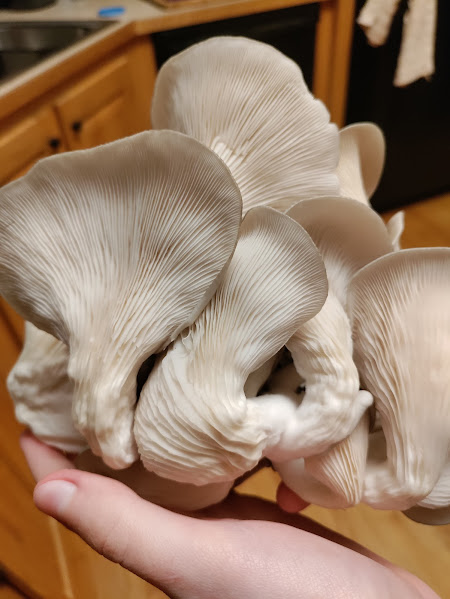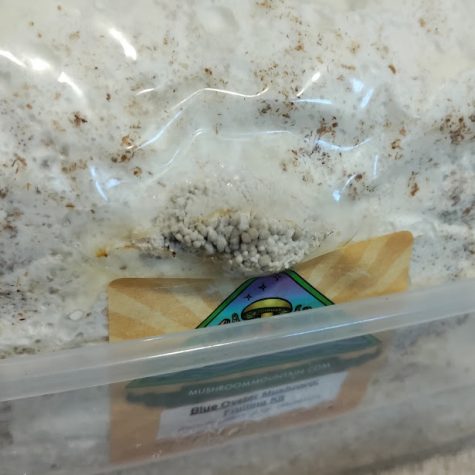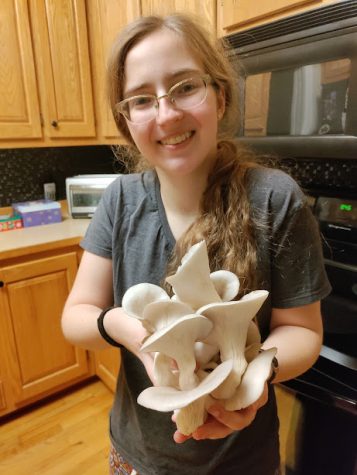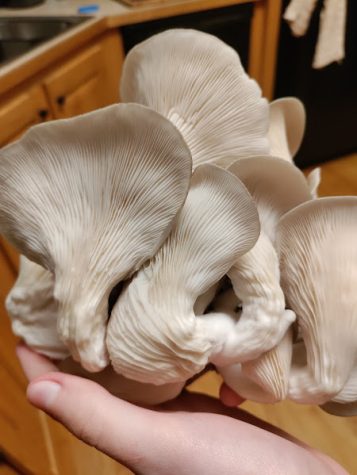How I Grew My Own Oyster Mushrooms
Oyster mushrooms are some of the easiest mushrooms to cultivate at home, and growing kits are readily available to order online. After only two weeks, mine were finally ready to pick.

The gills on the fully grown mushrooms formed an amazing pattern.

On a cold day in December, a package arrived at my doorstep. Inside was some rather unusual cargo: a large, tied-off plastic bag packed with dusty brown mulch, thick with a strange white substance that almost seemed to carpet the surface. In this carefully sealed bag was the mycelium of the Pleurotus ostreatus fungus, or the oyster mushroom. And I was going to attempt to grow it.
Ever since my fascination with mushrooms first developed, I was intrigued with the idea of growing them myself. I had read accounts of amateur mycologists fruiting enormous crops of all kinds of species with nothing but tupperware and sawdust, as well as through prepared fruiting kits that can be bought online, and soon began to research my options. Eventually, I found the South Carolina-based company Mushroom Mountain, which sells a variety of fruiting kits of many different species and growing methods. After a bit of research, I ordered my first mushroom kit: cold blue oyster mushrooms.

Oyster mushrooms are one of the most widely cultivated fungi, primarily for culinary use, but also for use in mycoremediation, in which the fungus is used to clean the environment of toxic substances such as heavy metals and to break down materials that would normally be extremely resistant to natural degradation. In some experiments, the mycelium of oyster mushrooms has been able to break down cigarette butts and used diapers, which has the potential to be incredibly beneficial in the search to find ways to reduce waste. Oyster mushrooms have also been used in traditional medicine for many years, and are chock-full of vitamins that give the immune system a natural boost. Not only that, they’re apparently some of the easiest mushrooms to grow, and will thrive in a fairly wide range of conditions compared to most other species. All I had to do to set up the kit was place it in a dish of water, carefully cut two small slits in the plastic casing, and leave it in a dimly lit area out of the range of direct sunlight. After that, all that was left to do was wait for the mycelium in the kit to grow through the substrate and begin to fruit.

For ten days, I waited for the first signs of the tiny oyster mushrooms to begin poking out from the plastic, but nothing much seemed to be happening in the kit. Although the white mycelium had appeared to slowly spread across the surface of the soil, there was nothing to tell me when my mushrooms were going to appear. Nevertheless, I tried not to worry; the instructions on the kit had told me the mycelium would probably take a few weeks to fruit. But sure enough, one day I arrived home from school to find a brown, bumpy growth emerging from one side of the kit. Only a few days later, this unassuming growth, at the time barely the size of a quarter, would burst forth into a magnificent flush of blue oyster mushrooms.
The growth of the mushrooms was incredible. The next morning, I woke up to find that the mushrooms had doubled in size over only twelve hours, their color deepening from a light brown-gray into a deep steel blue, and the mushrooms themselves had become far more visible, no longer tiny, round bumps on the surface of the central growth, but separate growths themselves, reaching out like a hundred tiny, rounded fingers into the air. In another twelve hours, the difference was even more noticeable:

I began to see the delicate gills on the undersides of their caps starting to form, and their caps widened along the stalk to become almost trumpet-shaped before later flattening out. Putting my head close to the growth, the mushrooms smelled sweet, earthy, and almost reminiscent of mint, and I knew that soon their thousands of spores would begin to disperse. To keep the mushrooms from drying out, I misted them with water every day and made sure their plastic humidity tent was in place to keep the moisture in.
Soon, however, the mushrooms outgrew the humidity tent entirely, much faster than I had thought. They were, well, mushrooming; each day I expected that it would be the last major change and that their growth would slow down, and each day they continued to expand. I began to wonder when I should pick the mushrooms; some websites suggested within three to five days, some suggested four to seven. But eventually, on the fifth day of growth, I surmised that they were unlikely to grow much bigger and decided to pick them. The mushrooms were enormous by then, some of their caps were bigger than my palm.

Although I was honestly sad to see the mushrooms go, I was also excited to see what the mushrooms I had waited so long for tasted like. Half of the mushrooms we roasted, and the other half we stored for a few days, then sauteed with chicken and balsamic vinegar. Both were delicious, but in my opinion, the sauteed mushrooms were the best ones I’ve ever had: perfectly chewy and crispy on the edges, with a delicate but strong earthy flavor.
If things go well, my kit should start to fruit again in the next couple of weeks. But even if it doesn’t, I definitely intend on growing more oyster mushrooms and experimenting with different species. It was absolutely fascinating to watch them grow in almost real time, and I would definitely recommend it for anyone curious about mushrooms.

